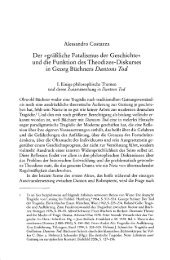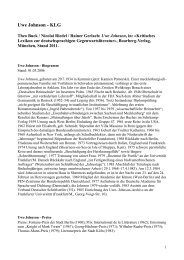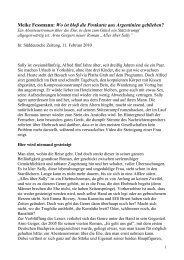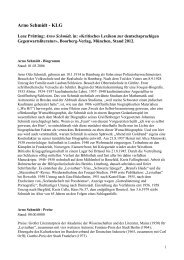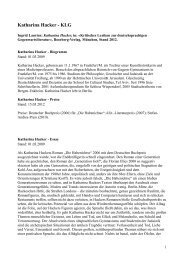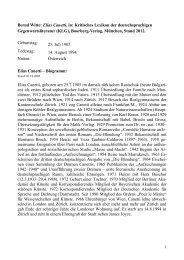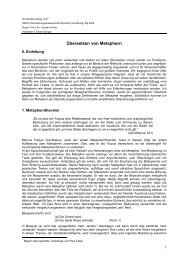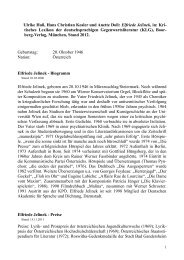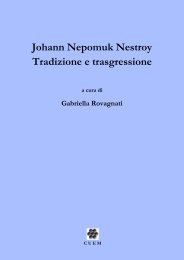Current Opinion in Investigational Drugs
Current Opinion in Investigational Drugs
Current Opinion in Investigational Drugs
Create successful ePaper yourself
Turn your PDF publications into a flip-book with our unique Google optimized e-Paper software.
36 <strong>Current</strong> <strong>Op<strong>in</strong>ion</strong> <strong>in</strong> <strong>Investigational</strong> <strong>Drugs</strong> 2006 Vol 7 No 1<br />
Several studies have shown that magnesium chloride and the<br />
synthetic polyam<strong>in</strong>e sperm<strong>in</strong>e <strong>in</strong>hibit the b<strong>in</strong>d<strong>in</strong>g of gabapent<strong>in</strong><br />
to high-aff<strong>in</strong>ity b<strong>in</strong>d<strong>in</strong>g sites, presumably α2δ subunits, <strong>in</strong> rats<br />
[39••], mice [59] and pigs [42]. Intrathecal <strong>in</strong>fusion of<br />
magnesium chloride effectively attenuates the anti-allodynic<br />
effect of gabapent<strong>in</strong> <strong>in</strong> a rat model [60••]. Nevertheless, the role<br />
of the α2δ subunit <strong>in</strong> the ant<strong>in</strong>europathic action of gabapent<strong>in</strong> is<br />
far from clear. Sperm<strong>in</strong>e had no effect on the efficacy of<br />
gabapent<strong>in</strong> <strong>in</strong> the same study [60••]. Furthermore, both<br />
magnesium chloride and sperm<strong>in</strong>e can promote gabapent<strong>in</strong><br />
b<strong>in</strong>d<strong>in</strong>g to purified α2δ subunit prote<strong>in</strong> and appear to have a<br />
temperature-dependent effect on the drug <strong>in</strong> mice, stimulat<strong>in</strong>g<br />
b<strong>in</strong>d<strong>in</strong>g at 30°C, and <strong>in</strong>hibit<strong>in</strong>g b<strong>in</strong>d<strong>in</strong>g at 4°C [59]. F<strong>in</strong>ally, both<br />
magnesium chloride and sperm<strong>in</strong>e are allosteric modulators of<br />
NMDA receptors and could <strong>in</strong>teract with gabapent<strong>in</strong> through a<br />
different site altogether [61].<br />
K + channel activation<br />
There have been some reports that gabapent<strong>in</strong> activates<br />
<strong>in</strong>wardly rectify<strong>in</strong>g K + channels, result<strong>in</strong>g <strong>in</strong> membrane<br />
hyperpolarization and decreased excitability [40•,62]. Ng et<br />
al found that gabapent<strong>in</strong> activates post-synaptic K + currents<br />
<strong>in</strong> rat bra<strong>in</strong> slices and Xenopus oocytes [40•]. However, this<br />
activation was dependent on expression of a specific cloned<br />
GABAB receptor subtype (gb1a-gb2). Furthermore, GABA<br />
had a similar effect on Xenopus oocytes express<strong>in</strong>g GABAB<br />
receptors, suggest<strong>in</strong>g that activation of K + currents is a<br />
receptor-mediated effect.<br />
Selective agonism at GABAB receptors (gb1a-gb2)<br />
GABA receptors are of two types; the multi-subunit chloride<br />
channel receptor GABAA subtype, at which gabapent<strong>in</strong> does<br />
not b<strong>in</strong>d <strong>in</strong> significant quantities [39••], and the G-prote<strong>in</strong>coupled<br />
GABAB receptor [63]. Although several studies have<br />
not found that gabapent<strong>in</strong> b<strong>in</strong>ds to any subtype of GABAB<br />
receptors to a significant degree [39••,64••,65], one group has<br />
provided evidence that expression of gb1a-gb2 GABAB<br />
receptors is prerequisite for gabapent<strong>in</strong> to alter membrane ion<br />
permeability [40•,66]. This is of particular <strong>in</strong>terest because<br />
agonism at GABAB receptors may account for both the<br />
gabapent<strong>in</strong>-mediated <strong>in</strong>hibition of voltage-gated Ca 2+ channels<br />
and activation of <strong>in</strong>wardly rectify<strong>in</strong>g K + channels [67••,68].<br />
A recent pharmacological study provides further evidence<br />
that an important <strong>in</strong>teraction occurs between gabapent<strong>in</strong><br />
and the subtype of GABAB receptors constitutively<br />
expressed on pre-synaptic regions of excitatory <strong>in</strong>terneurons<br />
to <strong>in</strong>hibit excitatory neurotransmitter release [69••].<br />
Importantly, GABAergic neurons were spared, and the<br />
effect of gabapent<strong>in</strong> on excitatory neurotransmitter release<br />
was sensitive to specific GABAB receptor antagonists. It is<br />
possible that GABAB receptor blockade prevented<br />
gabapent<strong>in</strong> action by <strong>in</strong>direct physiological antagonism [70],<br />
as residual GABA is likely to have been present <strong>in</strong> the rat<br />
bra<strong>in</strong> slices used for this experiment. However, this<br />
postulation does not expla<strong>in</strong> the direct effect of gabapent<strong>in</strong><br />
on a GABAB subtype expressed on Xenopus oocytes [40•].<br />
Increased GABA synthesis or release<br />
GABA is an important <strong>in</strong>hibitory neurotransmitter with<br />
numerous pharmacological <strong>in</strong>teractions [71]. Blockade of<br />
GABA causes hypersensitivity and allodynia consistent with<br />
neuropathic pa<strong>in</strong> [72], and partial nerve <strong>in</strong>jury reduces<br />
dorsal horn synaptic <strong>in</strong>hibition ow<strong>in</strong>g to apoptosis of<br />
GABAergic <strong>in</strong>terneurons [4]. As discussed previously,<br />
gabapent<strong>in</strong> does not have a direct action at GABAA receptors<br />
[38], GABA-receptor-block<strong>in</strong>g drugs do not alter the<br />
ant<strong>in</strong>europathic efficacy of gabapent<strong>in</strong> [73], and gabapent<strong>in</strong><br />
has no effect on GABA reuptake [74]. However, synthesis<br />
and release of GABA <strong>in</strong> the bra<strong>in</strong> are <strong>in</strong>creased by<br />
gabapent<strong>in</strong> [75,76], and magnetic resonance imag<strong>in</strong>g<br />
spectroscopy of epileptic patients tak<strong>in</strong>g gabapent<strong>in</strong><br />
demonstrated a global <strong>in</strong>crease <strong>in</strong> bra<strong>in</strong> GABA [77]. This<br />
observation may be because of <strong>in</strong>hibition of GABAtransam<strong>in</strong>ase<br />
[78], activation of glutamic acid decarboxylase<br />
[79] that is sufficient to <strong>in</strong>crease GABA synthesis by 50 to<br />
100% [80], or promotion of non-vesicular GABA release [81].<br />
In an <strong>in</strong>terest<strong>in</strong>g contrast with the f<strong>in</strong>d<strong>in</strong>g of Parker et al that<br />
gabapent<strong>in</strong> acts on pre-synaptic GABAB receptors to <strong>in</strong>hibit<br />
excitatory neurotransmitter release while spar<strong>in</strong>g<br />
GABAergic neurons [69••], gabapent<strong>in</strong> <strong>in</strong>creased the<br />
extrasynaptic NMDA-mediated current <strong>in</strong> GABAergic, but<br />
not non-GABAergic, neurons <strong>in</strong> a rat model of <strong>in</strong>flammatory<br />
pa<strong>in</strong> [82,83]. This action may <strong>in</strong>crease activity <strong>in</strong> <strong>in</strong>hibitory<br />
sp<strong>in</strong>al cord <strong>in</strong>terneurons, thus releas<strong>in</strong>g GABA under<br />
conditions associated with neuropathic pa<strong>in</strong>. However,<br />
neither NMDA receptor modulation [60••] nor GABA<br />
receptor blockade [73] significantly alters the efficacy of<br />
gabapent<strong>in</strong> <strong>in</strong> rat models of pa<strong>in</strong>.<br />
Increase <strong>in</strong> peripheral whole-blood seroton<strong>in</strong><br />
Mood has a profound effect on perception of pa<strong>in</strong> [84], so it<br />
is a realistic possibility that some of the analgesic effects of<br />
gabapent<strong>in</strong> <strong>in</strong> humans may be mediated by global<br />
serotonergic activation [85]. Indeed, gabapent<strong>in</strong> has been<br />
used to treat a variety of mood and anxiety disorders,<br />
although randomized cl<strong>in</strong>ical trials have so far been<br />
disappo<strong>in</strong>t<strong>in</strong>g [86]. Direct evidence from rats has<br />
contradicted this postulated mechanism; neither pretreatment<br />
of rats with a central nervous system seroton<strong>in</strong>deplet<strong>in</strong>g<br />
compound [73] nor blockade of seroton<strong>in</strong><br />
receptors [87] had any effect on the antihyperalgesic efficacy<br />
of gabapent<strong>in</strong>. We conclude that seroton<strong>in</strong> is unlikely to be<br />
central to the mechanism of action of gabapent<strong>in</strong>.<br />
Conclusions<br />
Despite its orig<strong>in</strong>al conception as a drug designed to mimic<br />
a specific neurotransmitter, gabapent<strong>in</strong> has become widely<br />
established <strong>in</strong> cl<strong>in</strong>ical practice without a satisfactory<br />
explanation of how it works. As summarized above, debate<br />
regard<strong>in</strong>g its mechanisms of action now centers on the<br />
apparent discrepancy between the high-aff<strong>in</strong>ity b<strong>in</strong>d<strong>in</strong>g site<br />
on α2δ subunits of voltage-gated Ca 2+ channels [34••], and<br />
persuasive evidence of a direct action at GABAB receptors<br />
[40•].<br />
It has been difficult to dist<strong>in</strong>guish between direct effects of<br />
the drug at Ca 2+ channels and receptor-mediated <strong>in</strong>hibition<br />
of Ca 2+ current because of an apparently ubiquitous<br />
physiological <strong>in</strong>terdependence. Both actions occur at<br />
therapeutically relevant concentrations, and both may




